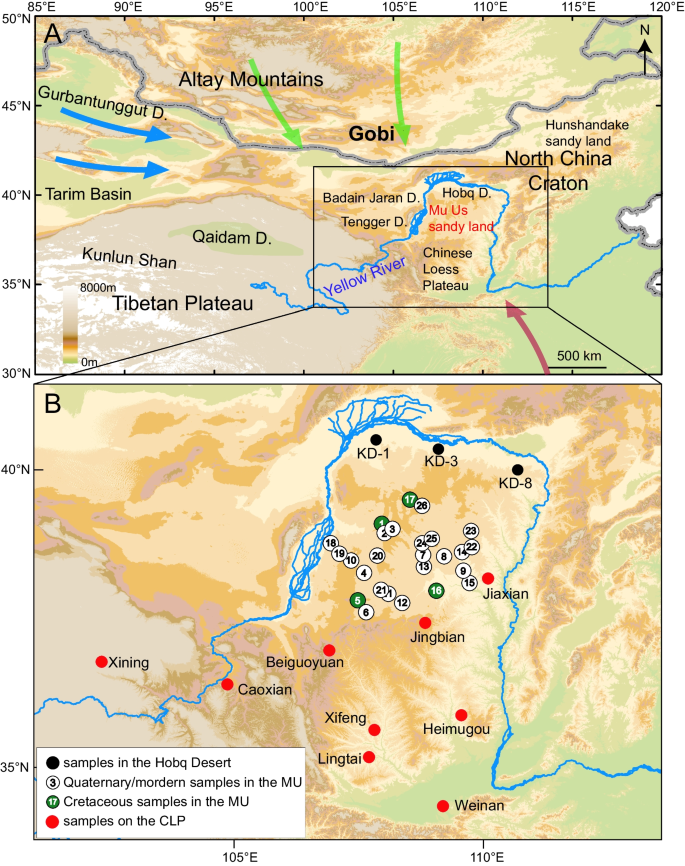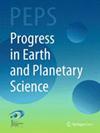碎屑锆石U-Pb测年约束下毛乌素沙地物源分异及地表过程
IF 2.8
3区 地球科学
Q1 GEOSCIENCES, MULTIDISCIPLINARY
引用次数: 0
摘要
了解毛乌素沙地(Mu)的物源和沉积过程对理解亚洲内陆和中国黄土高原(CLP)的风沙沉积和沙尘运移具有重要意义。在本研究中,我们结合库布齐沙漠和CLP沉积物中已有的数据,分析了MU沉积物中的碎屑锆石U-Pb年龄。研究结果表明,内蒙古和库布齐地区沉积物特征存在空间异质性,东北和西南地区差异显著。此外,中关带东北部与中关带其他区域存在显著差异。东北MU、东Hobq和东北CLP继承了华北克拉通西部基底岩的主要特征,年龄范围1600 ~ 2200 Ma和2200 ~ 2800 Ma突出,表明该地区可能更多地受到原位风化和再循环的控制。与此相反,西南MU、库布旗西部-中部及中川大部分地区的风沙源较多,200-350 Ma和350-600 Ma的风沙源所占比例较高,说明该地区的风沙沉积可能与吹沙风、河流输运等地表作用更为频繁有关。虽然这三个区域都位于黄河的方形弯道内,处于盛行风向下,但前两个区域的沉积物似乎有更多的本地和远端来源的混合贡献。与此相反,CLP地区的沉积物主要来自青藏高原东北部的黄河上游。这表明从北到南沙尘源的变化,表明MU与CLP是同一沉积体系的一部分,而不是其直接来源。本文章由计算机程序翻译,如有差异,请以英文原文为准。

Provenance differentiation and earth surface process of the Mu Us sandy land constrained by detrital zircon U–Pb dating
Abstract Understanding the provenance and sediment surface processes of the Mu Us sandy land (MU) is critical for comprehending aeolian deposits and dust transportation in inland Asia and the Chinese Loess Plateau (CLP). In this study, we analyzed the detrital zircon U–Pb ages in the sediments of the MU, together with the previously collected data from sediments in the Hobq desert and CLP. Our findings demonstrate that there is spatial heterogeneity in the sediment characteristics of the MU and Hobq regions, with noticeable differences between northeastern and southwestern areas. In addition, the northeastern part of the CLP displays significant dissimilarities from other regions of the CLP. The NE MU, Eastern Hobq, and NE CLP inherit the main characteristics of basement rocks from the Western North China Craton, with prominent age ranges of 1600–2200 Ma and 2200–2800 Ma, indicating that this region is likely more controlled by in-situ weathering and recycling. In contrast, the SW MU, West-Middle Hobq and most parts of CLP show multiple sources, with a higher proportion of 200–350 Ma and 350–600 Ma, reflecting that the aeolian deposits in this area may be associated with more frequent earth surface processes such as sand-driving winds and fluvial transport. Although all three regions are situated within the square bend of the Yellow River and under the prevailing winds direction, sediments in the first two areas appear to have a more mixed contribution of both local and distal sources. In contrast, deposits in the CLP region were primarily sourced from the northeast Tibetan Plateau via the upper Yellow River. This indicates a variation in dust sources from north to south and suggests that the MU is part of the same sedimentary system as the CLP, rather than its direct source.
求助全文
通过发布文献求助,成功后即可免费获取论文全文。
去求助
来源期刊

Progress in Earth and Planetary Science
Earth and Planetary Sciences-General Earth and Planetary Sciences
CiteScore
6.50
自引率
5.10%
发文量
59
审稿时长
31 weeks
期刊介绍:
Progress in Earth and Planetary Science (PEPS), a peer-reviewed open access e-journal, was launched by the Japan Geoscience Union (JpGU) in 2014. This international journal is devoted to high-quality original articles, reviews and papers with full data attached in the research fields of space and planetary sciences, atmospheric and hydrospheric sciences, human geosciences, solid earth sciences, and biogeosciences. PEPS promotes excellent review articles and welcomes articles with electronic attachments including videos, animations, and large original data files. PEPS also encourages papers with full data attached: papers with full data attached are scientific articles that preserve the full detailed raw research data and metadata which were gathered in their preparation and make these data freely available to the research community for further analysis.
 求助内容:
求助内容: 应助结果提醒方式:
应助结果提醒方式:


